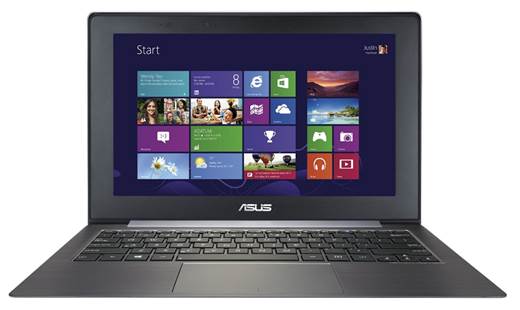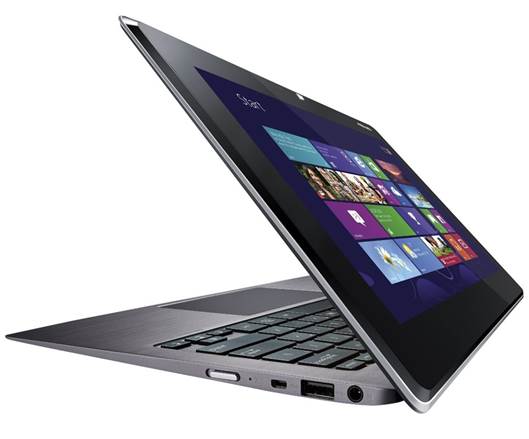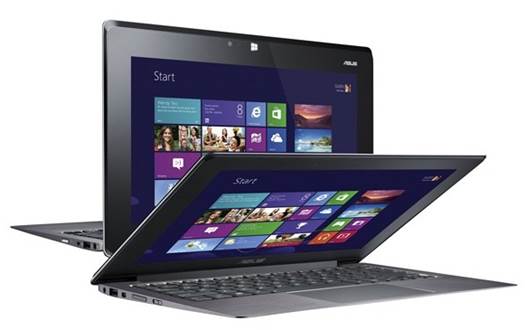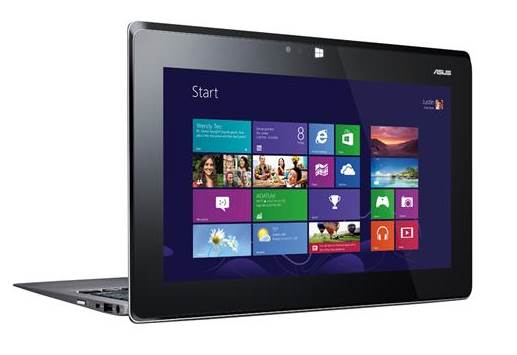A bold, dual-screened vision of the
convertible tablet, but ergonomic niggles and mediocre battery life see it fall
short of the mark
Asus is no stranger to innovation: its
range of Transformer Pads was the first to successfully fuse the Android tablet
and netbook. Now it's attempting to repeat the feat with Windows 8. Enter the
Taichi 21, Asus' unique take on the Windows 8 convertible tablet.

From afar, it's easy to mistake the Taichi
21 for a classy, slimline Ultrabook. Flip back the glass-covered lid, and the
Taichi looks like a tweaked version of Asus' Zenbook UX21E, or a more high-end
vision of the VivoBook S200E. There's a full keyboard, multitouch touchpad, and
an 11.6in matte IPS Full HD panel above. Dark-grey metal and glass reaches all
around, and the slender chassis measures 18mm thick and weighs only 1.25kg.
Surprisingly, though, this slim chassis
houses not one but two screens. Shut the lid, or press the dedicated button on
the keyboard, and that glass lid is illuminated by a Full HD IPS touch panel,
complete with a touch-sensitive Windows 8 button in the bezel below.

Dark-grey
metal and glass reaches all around, and the slender chassis measures 18mm thick
and weighs only 1.25kg.
The flexibility is undeniably novel: it's
possible to mirror the image shown on both the front and rear displays
simultaneously, use one at a time, or utilise the rear display as a secondary
monitor.
The twin-screen design enables the Taichi
to be used in a variety of configurations. As a standard laptop it works
without fuss, thanks to the comfy backlit keyboard and the wide multitouch
touchpad. We're also pleased to see that Asus has employed a less reflective,
semi-gloss finish on the internal display.
As a tablet, the hinged design means that
the Toichi can be folded flat or pivoted upwards to face the user without the
need for a third- party case or stand. The included stylus, meanwhile, provides
pressure- sensitive inking, thanks to the N-trig digitiser panel pressed
beneath the protective Gorilla Glass topping. It's a shame there isn't a place
to stash the stylus in the Taichi itself; there is a slot for it in the
supplied slip cover, however.
Hardware
Visually, the Taichi's twin IPS displays
mean Windows 8 looks lovely in any orientation. Viewing angles are wide,
colours are rich, and while the outer display's Gorilla Glass layer gives
images tremendous punch, the laptop display's semi-gloss finish cuts down on
distracting reflections.
Colour accuracy is slightly off, with the
low 5563K colour temperature of both screens giving images a worm, rosy tone.
But the high contrast ratio of 965:1 delivers punchy images, with detail
revealed in even the darkest scenes. Asus has had to make compromises to
squeeze two backlights bock to back: the laptop display reaches 222cd/m2, and
the tablet display reaches an average 245cd/m2; both are dimmer than we'd like.

Visually,
the Taichi's twin IPS displays mean Windows 8 looks lovely in any orientation.
In addition to the twin displays, Asus has
crammed in a high-end specification. Our review model came with an Intel Core
i7-3517U processor, 4GB of memory and a 256GB SSD. The result of 0.66 in our
Real World Benchmarks isn't lightning quick, but the pairing of a Core i7 CPU
and SSD remains potent enough to keep the Taichi feeling responsive. It's
disappointing that the 4GB of memory is soldered onto the motherboard,
preventing further upgrades.
Gaming isn't a strong point, either: while
casual games or side-scrolling plat formers from the Windows Store will run
without fuss, more demanding titles will soon overpower the Intel HD Graphics
4000 GPU. In our Crysis benchmark run at 1600 x 900 and Medium quality, the
Taichi fought its way to an average frame rate of only 17fps.
Another frustration is the sluggish
transition between tablet and laptop display. Snap the lid shut, and the tablet
display takes over in just under three seconds; flip the lid open again, and it
takes another three seconds for it to kick into action.
As ever, battery life is crucial for such a
device, and here the Taichi struggles. We ran our light-use battery test in
both tablet and laptop modes, and in both scenarios the Taichi lasted just under
five hours. On the rare occasion that both displays are running simultaneously,
that figure will tumble dramatically. Thankfully, though, the wall-wart PSU
weighs only 212g, so it doesn't add too much to the overall travelling weight.
The greatest asset of the Taichi's design
is that, as a laptop, there's no compromise. The Scrabble-tile keys have a
light yet positive action, and the layout is perfect, with a wide right-Shift
key and a usable cluster of cursor keys. The touchpad works well too. Windows 8's
edge gestures are supported, allowing you to drag a finger from the right of
the touchpad to activate the Charms menu, or from the left to flick between
apps. Multi-touch gestures work well, along with two-fingered taps to emulate a
right-click; we had an occasional issue with the pad not responding to gestures
due to the slight lip around the touch pad's edge.

The
greatest asset of the Taichi's design is that, as a laptop, there's no
compromise
Running the Taichi in tablet mode is less
pleasing. The problem isn't the touchscreen itself: it's responsive, and the
N-trig digitiser provides accurate inking support.
Using it at a desk is also improved by the
ability to tilt the display upwards. The weight of the base holds the Taichi
steady, and the hinge is stiff enough that you have to prod forcefully before
the display nudges backwards.
However, the biggest downside of the
Taichi's design is that 1.25kg is far too heavy for comfortable long-term use.
Holding it in tablet mode is tiring, and much as we appreciate the ability to
flit quickly between the laptop and tablet simply by flicking the lid open and
closed, the weight penalty is severe.
The Taichi's split personality also causes
other woes. Try as we might, we kept instinctively reaching out and prodding
the laptop display, only to remember that it wasn't a touchscreen. Where we
found ourselves instinctively flitting from touchpad to touchscreen and back
again with the single touchscreen of Asus' VivoBook S200E, the Taichi's
separate tablet and laptop modes sit more awkwardly, with the transition from
one to the other feeling for less intuitive.
Many manufacturers are struggling to find
the most natural meeting point between the tablet and the laptop, and Asus' own
Windows 8 range provides yet more evidence of this. With its VivoBooks marrying
touchscreens to standard laptops, the forthcoming VivoTab range mimicking the
separate tablet and keyboard dock concept of the Android-powered Transformer
Pad, and the Taichi 21 ploughing its own dual-screened furrow, it seems even
Asus isn't confident enough to put all of its eggs in one basket.
Give it a few years and a refined, lighter
chassis married with more power-efficient CPUs and improved battery life could
see this dual screened form factor present a compelling hybrid. At present,
though, Asus' Taichi 21 feels like a bold, innovative concept that's just a
little too far ahead of its time.
|
Specifications
·
Processor: Intel® Core™ i7 3517U Processor;
Intel® Core™ i5 3317U Processor
·
Operating System: Windows 8 Pro; Windows 8
·
Chipset: Intel® QS77 Express Chipset
·
Memory: DDR3 1600 MHz SDRAM, OnBoard Memory 4
GB
·
Display: 11.6" 16:9 Full HD (1920x1080)
·
Graphic: Integrated Intel® HD Graphics 4000
·
Storage: SATA III SSD
Camera: HD Web Camera
·
Networking: Integrated 802.11 a/b/g/n;
Built-in Bluetooth™ V4.0
Audio: Bang & Olufsen ICEpower®
·
Battery: 35 Whrs Polymer Battery
Power Adapter: Output: 19 V DC, A, 45 W; Input: 100 -240 V AC, 50/60 Hz
universal
·
Dimensions: 30.66 x 19.93 x 1.74 cm (WxDxH)
·
Weight: 1.25 kg
·
Manufacturer Warranty: 1-year limited
International hardware warranty.
|